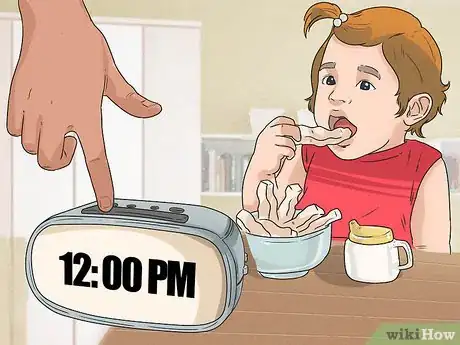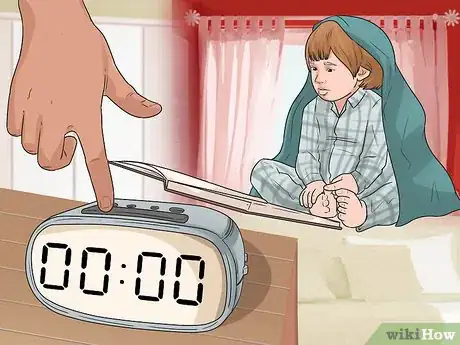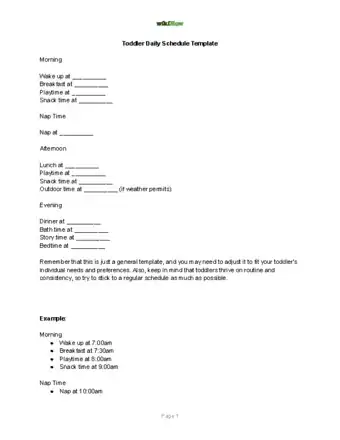This article was co-authored by Wits End Parenting. Wits End Parenting is a parent-coaching practice based in Berkeley, California specializing in strong-willed, “spirited” children with impulsivity, emotional volatility, difficulty “listening,” defiance, and aggression. Wits End Parenting's counselors incorporate positive discipline that is tailored to each child’s temperament while also providing long-term results, freeing parents from the need to continually re-invent their discipline strategies.
There are 9 references cited in this article, which can be found at the bottom of the page.
This article has been viewed 87,672 times.
Setting a schedule for your toddler has many perks, from giving your toddler more confidence and stability to making your life easier as a parent.[1] The key to creating a good schedule for your toddler is a mix of structure, comfort, and fun. You should put the schedule into practice right away so your toddler gets used to their new routine and be willing to adjust the schedule as they get older to better fit their needs.
Steps
Creating the Schedule
-
1Establish a wake up time. Start your toddler’s day by setting a wake up time. Most toddlers get up early in the morning, around 6:30-6:45 am. If your toddler tends to get up later than 6:45 am, do not try to wake them up earlier. Let your toddler decide when they will wake up.[2] [3]
- You may set aside 15 minutes for your toddler to wake up slowly on their own and play a little in their crib before you get them ready for the day. You may try to wait until 7 am to initiate a start to your toddler’s day.
- You may then allow 30 minutes to dress the toddler and get the toddler to brush their teeth. You may also include a time to wash their face and go to the bathroom.
-
2Include a breakfast time. Depending on the needs of your toddler, you may actually schedule breakfast time before they brush their teeth and get dressed, as some toddlers wake up hungry. You can decide to feed your toddler first so they are more cooperative when it comes time to get dressed and brush their teeth.[4]
- Try to keep their breakfast light and easy to make. Allow for 30 minutes for your toddler to eat their breakfast. You want to keep the breakfast time short so your toddler has time to play in the late morning.
Advertisement -
3Create a late morning routine. Once your toddler is done with breakfast, you should create a late morning routine. Start with 1 hour of play time after breakfast where you read books together or allow your toddler to play with siblings or family members.[5]
- After 1 hour of playtime, you may schedule another hour of arts and crafts or do another activity together, like listening or dancing to music. Try to include at least 2 different activities in the late morning so your toddler has some variety and is not doing the same activity for the majority of the morning.
- You should try to include activities that are stimulating but also calming, like doing finger painting or drawing. Mixing in active and relaxing activities throughout your toddler’s day can help them get used to pacing themselves.[6]
- Keep in mind that toddlers have short natural attention spans (their age plus 1, in minutes—meaning a 3-year-old has an attention span of 4 minutes). Try to plan structured activities that fit into this time frame in order to keep your child engaged.
-
4Include a lunch time and a nap. You should stick to an afternoon lunch time, ideally at 12 pm. Allow your toddler 30-60 minutes to wash up and eat lunch.[7]
- After lunch at 12 pm, schedule in a nap. Toddlers between the ages of 1-2 years old need about 11-14 hours of sleep total.[8] Scheduling in a nap after lunch is ideal, as this will ensure your toddler is well rested before dinner but is still tired enough after dinner to go to sleep at night.
- Depending on the age of your toddler, you may include 2 naps a day, 1 in the late morning and 1 in the early afternoon, after lunch. Once your toddler reaches 18 months old, they will only need 1 nap a day, at 1-3 hours long.[9]
-
5Put in a late afternoon routine. After your toddler’s nap, you should plan a few activities for the late afternoon. This should include a light afternoon snack and some time outside, if possible. Plan for an activity outdoors like going for a walk to a nearby playground or running around outside in the yard.[10]
- Doing something physical outdoors in the late afternoon will also allow your toddler to get their energy out before dinner. This could make the preparations for dinner and bedtime much smoother.
-
6Make a before dinner plan. You should start getting your toddler ready for dinner about 30 minutes before dinner time. Try to establish a routine of washing their hands and face and changing out of any dirty clothing before dinner time. This will ensure your toddler knows what to expect before they sit down to eat.[11] [12]
- Have dinner time at the same time every day, usually around 5:30-6pm. You may allow for 1 hour for dinner, especially if your toddler is eating with the rest of the family. Dinner time can be a good way for your toddler to bond with everyone and also learn how to model good table manners by watching others eat.
-
7Include a before bed routine. It can be tricky to get your toddler to go to bed. But if you stick to a consistent day schedule and establish a before bed routine, your toddler may be more apt to go to bed. You should try to stick to the same before bed routine and the same bedtime every night. Most toddlers should be in bed by 8 pm to ensure they get enough sleep.[13]
- Include a brief playtime after dinner and allow your toddler to do something relaxing, like read a book or watch a favorite television show. You can also include a nighttime snack like a warm glass of milk.
- You may also include time for a warm bath before bed. Your toddler should also get into their pajamas and brush their teeth.
- The final step in your bedtime routine might be singing a quiet song in bed or reading a bedtime story. You may also allow your toddler to get into bed with a favorite toy or a comfort blanket. Having a security object in bed, such as a toy, can help your toddler fall asleep.[14]
-
8View the schedule as a whole. Once you feel you have a complete schedule set for your toddler, you should write it down and view it as a whole. Make sure you include enough daily activities that are active and also calming. You should also make sure you establish set wake times, nap times, and bedtimes for your toddler. Your schedule may look like this:[15]
- 6:30-6:45 am: Wake up time, with time set aside for playing in the crib/bed
- 7:30 am: Breakfast
- 8:00 am: Get dressed, brush teeth, wash face
- 8:30 am: Play time
- 10:30 am: Morning snack
- 11:00 am: Arts and crafts time
- 11:30 am: Calming activity
- 12:00 pm: Lunch time
- 12:30 pm: Nap time
- 2:30-3:00 pm: Afternoon snack
- 3:00 pm: Outdoor play time
- 5:30 pm: Dinner time
- 6:00-6:30 pm: Brief playtime
- 7:00 pm: Bath
- 7:30 pm: Before bed routine
- 8:00-8:15 pm: Bedtime
Putting the Schedule into Practice
-
1Create a poster of the schedule. You can reinforce your toddler’s schedule by creating a poster or image of the schedule and placing it in their room. This way, your child can look at the schedule every day and know exactly what the plan is. You can also refer to the schedule throughout the day to remind your toddler what they should expect.[16]
- You may also include photographs of your toddler doing each action, such as a photo of your child at play time or a photo of your child eating at the dinner table. This can serve as visual reinforcement of the schedule.
- Use a clothespin or other marker to note which part of the schedule you are on, moving the marker throughout the day. This can help ease transitions and let your child know that to expect.
- A poster of the schedule can also be useful if you have more than one child in your household. Your children may be on different schedules, depending on their ages and needs. Having posters of each schedule, with visual images of each child, can help make it easier for your children to follow their own individual schedules.
-
2Be flexible when needed. Though it is important that you maintain a set schedule for your toddler, you should not be too rigid or set about the schedule. You want your toddler to learn consistency and stability but you also want to be sure they can be adaptable in the event of a change.[17]
- You may introduce small changes to their schedule, like swapping out late morning reading time for a walk outside or having lunch picnic style outside on a nice day. Including small changes can keep your toddler’s days fun and interesting.
- You should still maintain a few non-negotiables in the routine so there is still a level of consistency. You may maintain the same wake up times, eating times, and bedtimes, but vary the activities between these times.
- Observe how your child adjusts to the schedule and make changes if necessary. For instance, if your child seems sleepy during lunchtime, you may need to move their lunchtime up so they can take an earlier nap.
-
3Add variety to the schedule. You should also try to vary up who does what for your toddler throughout the day. Adding variety in terms of who does what role in your toddler’s schedule will ensure they do not become too dependent on one person.[18]
- Maybe alternate nights where your partner or a family member puts your toddler to bed so they do not too dependent on you always being there at bedtime. You may also change up who serves your toddler lunch so other family members are involved in their routine.
- You may also have a babysitter come by a few times a week to give your toddler dinner and put them to bed so they get used to having people outside the family involved in their routine.
-
4Include incentives for your toddler to follow the schedule.[19] You should make sure your toddler’s schedule includes enough time for them to have fun, explore, learn, and engage with you on an intimate level. You should also make sure your toddler feels they are benefitting from the schedule in tangible ways. Use the routines in their schedule as incentives so your toddler is more interested in the schedule and follows it willingly.[20]
- For example, you may make sure there is enough one on one time with your toddler throughout their daily routine so they feel they are benefitting from the schedule. You may also include some of their favorite activities in the play time slots of the schedule so they are excited for their routine.
Adjusting the Schedule Over Time
-
1Add more play time with other toddlers. As your toddler gets older and reaches 2 years of age, they should start to play with other toddlers regularly. They may play with other children their age in a group or one on one. You should arrange for play dates during your toddler’s play times so they are spending time with other children.[21]
- You may try to include a variety of activities with other children in your toddler’s schedule. Make time for big group activities, small group activities, and one one one play with other children their age. This will ensure they learn the value of friendship, community, and getting along with others.
-
2Change one aspect of the schedule at a time. If you decide it is time to change up one aspect of your toddler’s schedule, do so gradually and one aspect at a time. Avoid shifting several routines at once as this can confuse your toddler.[22]
- You may decide to start by shifting one aspect of your toddler’s schedule in the evenings, as this will give you time to stay organized and on schedule in the mornings. You may decide to move down your toddler’s bedtime as they get older or change dinner times due to a new schedule at school or at work.
-
3Stick to the same schedule for at least 2 months. Two months is a good amount of time for your toddler to get used to the schedule. Many toddlers start to maintain the schedule on their own after 2 months and will come to expect certain routines in their day.[23] [24]
- If a drastic event occurs, such as family emergency, you should use plain language to explain to your toddler that there is going to be a change to the schedule. You may say, “Grandpa is sick so I am going to take care of him. Dad is going to put you to bed tonight.” This will reassure your toddler everything is fine and that the change is not going to disrupt their schedule.
- You should also try to maintain the same schedule when you are on vacation with your toddler or away from home. Maintain the same nap times and bedtimes can make it easier for your toddler to stay calm during the trip and feel less unsettled by being away from home.
Toddler Daily Schedule Template
References
- ↑ http://www.parents.com/toddlers-preschoolers/development/social/establishing-toddler-routines/
- ↑ http://www.themilitarywifeandmom.com/5-sample-daily-toddler-schedule-from-real-moms/
- ↑ http://www.parents.com/toddlers-preschoolers/development/social/establishing-toddler-routines/
- ↑ http://www.parents.com/toddlers-preschoolers/development/social/establishing-toddler-routines/
- ↑ http://www.parents.com/toddlers-preschoolers/development/social/establishing-toddler-routines/
- ↑ http://articles.extension.org/pages/25720/establishing-predictable-routines-in-a-child-care-setting
- ↑ http://www.parents.com/toddlers-preschoolers/development/social/establishing-toddler-routines/
- ↑ https://sleepfoundation.org/sleep-topics/children-and-sleep/page/0/1
- ↑ https://sleepfoundation.org/sleep-topics/children-and-sleep/page/0/1
- ↑ http://www.parents.com/toddlers-preschoolers/development/social/establishing-toddler-routines/
- ↑ http://www.parents.com/toddlers-preschoolers/development/social/establishing-toddler-routines/
- ↑ http://www.themilitarywifeandmom.com/5-sample-daily-toddler-schedule-from-real-moms/
- ↑ http://www.whattoexpect.com/toddler/photo-gallery/best-bedtimes-routines-for-toddlers.aspx
- ↑ https://sleepfoundation.org/sleep-topics/children-and-sleep/page/0/2
- ↑ http://www.parents.com/toddlers-preschoolers/development/social/establishing-toddler-routines/
- ↑ http://www.ahaparenting.com/ask-the-doctor-1/starting-a-family-routine
- ↑ http://www.parents.com/toddlers-preschoolers/development/social/toddler-routines-schedules/
- ↑ http://www.parents.com/toddlers-preschoolers/development/social/toddler-routines-schedules/
- ↑ Wits End Parenting. Parenting Specialists. Expert Interview. 5 March 2020.
- ↑ http://www.ahaparenting.com/ask-the-doctor-1/starting-a-family-routine
- ↑ http://articles.extension.org/pages/25720/establishing-predictable-routines-in-a-child-care-setting
- ↑ http://www.ahaparenting.com/ask-the-doctor-1/starting-a-family-routine
- ↑ http://www.ahaparenting.com/ask-the-doctor-1/starting-a-family-routine
- ↑ http://www.parents.com/toddlers-preschoolers/development/social/toddler-routines-schedules/
About This Article
Toddlers can have a short attention span and find it difficult to settle down, so setting a schedule for your child can really help. Set their wake up time for when they usually get up and stick to it every day. Give them about 15 to 30 minutes to wake up and play in their crib before breakfast. After breakfast, schedule a few hours of playtime with a mix of calming but stimulating activities like arts and crafts or listening to music. Schedule lunch for about midday, then let them nap for 1 to 3 hours. In the afternoon, have your toddler do some energetic activities, like playing in the park or playing with other kids, to wear them out before dinner. After they’ve eaten, help them wind down by reading or watching TV with them. Bedtime can be hard, but if you stick to the routine, they’ll get used to going to bed at the same time. For more tips from our Childcare co-author, including how to build snacks into your toddler’s daily routine, read on!











































































